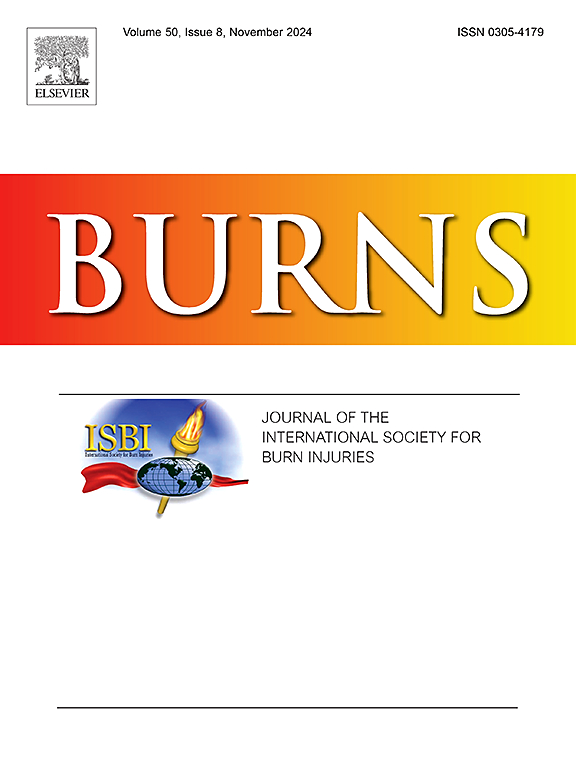Repurposing verapamil hydrochloride with niosomal gel technology: Enhanced efficacy and skin penetration in hypertrophic scars
IF 3.2
3区 医学
Q2 CRITICAL CARE MEDICINE
引用次数: 0
Abstract
Hypertrophic scars arising from abnormal wound healing after burns, trauma, or surgery present challenges for their effective treatment. Verapamil hydrochloride (VHCl), a calcium channel blocker primarily used in cardiovascular diseases, has been proposed as a niosomal gel for topical hypertrophic scar treatment. VHCL stimulates procollagenase synthesis, induces actin filament depolymerization, and reduces fibrous tissue production, thus making it a promising candidate for scar therapy. Prior to formulation, FT-IR spectroscopy was performed to assess drug and excipient compatibility. VHCl niosomes were prepared using the thin-film hydration technique with Span-40 and cholesterol in a 7:3 molar ratio. The characterization included entrapment efficiency (%EE), vesicle size, and surface morphology. Optimized niosomes were incorporated into a gel, and in in-vitro drug release and stability studies were conducted. An in-vivo study was conducted using a rabbit model to assess formulation efficacy. Optimized VHCl niosomal formulations with high entrapment efficiency (%EE) of 71.62 % and a small vesicle size of 180 nm were used for characterization, in-vitro and in-vivo evaluations. The vesicles displayed a monodisperse distribution, spherical and irregular morphology under TEM, and good stability for 60 days at room and refrigerated temperatures. The lyophilized formulation incorporated into the silicone gel exhibited optimal pH, thixotropic rheological behavior, and sustained VHCl release for up to 48 h. In-vivo studies on a rabbit ear model revealed enhanced efficacy, reducing hypertrophic scar diameter from 7 mm to 1.9 mm after 28 days. The combination of VHCl-loaded niosomal gels demonstrated improved permeation and synergistic effects, enhancing the safety and efficacy of long-term VHCl treatment.
用niosomal gel技术重新利用盐酸维拉帕米:增强增生性疤痕的疗效和皮肤穿透性
由于烧伤、创伤或手术后伤口愈合异常而引起的增生性疤痕对其有效治疗提出了挑战。盐酸维拉帕米(VHCl)是一种主要用于心血管疾病的钙通道阻滞剂,已被提议作为一种niosomal gel用于局部肥厚性疤痕治疗。VHCL刺激前胶原酶合成,诱导肌动蛋白丝解聚,减少纤维组织的产生,因此使其成为疤痕治疗的有希望的候选者。在配制之前,进行傅里叶变换红外光谱以评估药物和辅料的相容性。用Span-40和胆固醇按7:3的摩尔比,采用薄膜水化技术制备了VHCl膜小体。表征包括包封效率(%EE)、囊泡大小和表面形态。将优化后的纳米体掺入凝胶中,进行体外药物释放和稳定性研究。采用家兔模型进行体内研究,以评估制剂的功效。采用包封效率(%EE)为71.62 %,囊泡大小为180 nm的优化VHCl niosomal formulations进行表征、体外和体内评价。在TEM下,囊泡呈单分散分布,呈球形和不规则形态,在室温和冷藏条件下具有良好的60 d稳定性。冻干制剂加入到硅胶中,表现出最佳的pH值,触变流变行为,并持续释放VHCl长达48 h。兔耳模型的体内研究显示,28天后,肥厚性疤痕直径从7 mm减少到1.9 mm。负载VHCl的niosomal gel联合使用可改善VHCl的渗透和协同作用,提高VHCl长期治疗的安全性和有效性。
本文章由计算机程序翻译,如有差异,请以英文原文为准。
求助全文
约1分钟内获得全文
求助全文
来源期刊

Burns
医学-皮肤病学
CiteScore
4.50
自引率
18.50%
发文量
304
审稿时长
72 days
期刊介绍:
Burns aims to foster the exchange of information among all engaged in preventing and treating the effects of burns. The journal focuses on clinical, scientific and social aspects of these injuries and covers the prevention of the injury, the epidemiology of such injuries and all aspects of treatment including development of new techniques and technologies and verification of existing ones. Regular features include clinical and scientific papers, state of the art reviews and descriptions of burn-care in practice.
Topics covered by Burns include: the effects of smoke on man and animals, their tissues and cells; the responses to and treatment of patients and animals with chemical injuries to the skin; the biological and clinical effects of cold injuries; surgical techniques which are, or may be relevant to the treatment of burned patients during the acute or reconstructive phase following injury; well controlled laboratory studies of the effectiveness of anti-microbial agents on infection and new materials on scarring and healing; inflammatory responses to injury, effectiveness of related agents and other compounds used to modify the physiological and cellular responses to the injury; experimental studies of burns and the outcome of burn wound healing; regenerative medicine concerning the skin.
 求助内容:
求助内容: 应助结果提醒方式:
应助结果提醒方式:


